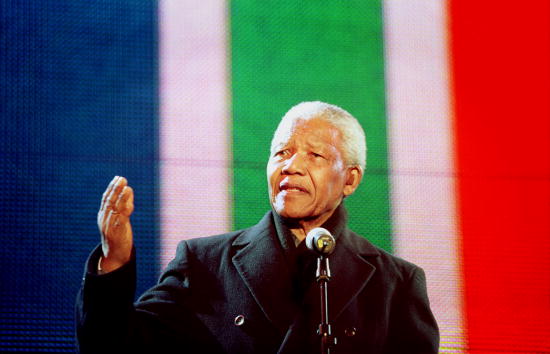
When Nelson Mandela gained the first-ever multiracial presidential election in South Africa on Could 2, 1994, the liberty fighter modified the course of historical past. The world witnessed a second that was each deeply symbolic and profoundly transformative. After spending 27 years as a political prisoner below South Africa’s brutal apartheid regime, Mandela emerged not simply as a free man, however as a pacesetter decided to heal a divided nation. His presidency marked the start of a brand new period in South African historical past, one rooted in justice, equality, and reconciliation.
That second got here in April 1994. In response to CBS Information, the election passed off over 4 days, from April 26 to 29. The primary day was designated for the aged, folks with disabilities, pregnant girls, prisoners, and expatriates. In lengthy, winding traces that stretched for miles—particularly in predominantly Black communities—tens of millions of South Africans waited patiently, some for hours, to forged their first-ever vote. Regardless of remoted incidents of violence, the voter turnout was astounding. In response to Historical past, greater than 22 million South Africans participated within the election.
Mandela’s African Nationwide Congress gained by a large margin, and in a strong second of nationwide therapeutic, he shaped a coalition authorities that included former President F.W. de Klerk’s Nationwide Social gathering and the Inkatha Freedom Social gathering, led by Zulu chief Mangosuthu Buthelezi. On Could 10, 1994, Nelson Mandela was formally sworn in as South Africa’s first Black president.
His inauguration marked greater than only a political transition, it was a worldwide image of hope, resilience, and the facility of forgiveness. Standing earlier than the world, Mandela delivered a message that may echo via historical past:
“The time for the therapeutic of the injuries has come. The second to bridge the chasms that divide us has come,” Mandela mentioned throughout his acceptance speech, per Reuters. “We’ve got, ultimately, achieved our political emancipation.”
From prisoner to president.
Mandela’s rise from political prisoner to president is among the most extraordinary political tales of the twentieth century. A tireless advocate for justice and equality, Mandela spent a long time combating to dismantle South Africa’s apartheid system, a brutal regime of institutionalized racism that oppressed the nation’s Black majority for almost half a century. His mission was not solely to finish apartheid, however to construct a democratic South Africa based on reconciliation, equality, and human rights.
Mandela’s political journey started in 1944 when, as a younger lawyer, he joined the African Nationwide Congress (ANC), South Africa’s oldest Black political group. He rapidly rose via the ranks, serving to to type the ANC Youth League and later turning into deputy nationwide president in 1952, Historical past famous. For years, Mandela and the ANC promoted nonviolent resistance. However after the 1960 Sharpeville bloodbath, during which police killed 69 unarmed Black protestors, Mandela co-founded the ANC’s armed wing, turning to sabotage in a bid to dismantle apartheid by any means crucial.
This shift in technique got here at a heavy worth. In 1961, Mandela was arrested for treason and acquitted, however he was arrested once more the next yr for leaving the nation illegally. He was sentenced to 5 years in jail, however throughout that point, he and several other different ANC leaders had been placed on trial once more, this time for sabotage. In 1964, Mandela was sentenced to life in jail.
Mandela would go on to spend 27 years behind bars, 18 of these on Robben Island, a distant and harsh jail off the coast of Cape City. Confined to a small cell with no mattress or plumbing and compelled to carry out exhausting labor in a limestone quarry, Mandela endured situations meant to interrupt him. But, he remained robust. He led a motion of civil resistance from inside the jail partitions, efficiently pressuring the South African authorities to enhance jail situations. He grew to become the enduring image of the anti-apartheid wrestle world wide.
The tide started to show in 1989 when F.W. de Klerk grew to become president of South Africa. Recognizing the inevitability of change, de Klerk started dismantling the apartheid system. In a sweeping set of reforms, he lifted the ban on the ANC, halted executions, and, in February 1990, ordered Mandela’s launch.
Mandela walked free after almost three a long time, not with vengeance in his coronary heart, however with a imaginative and prescient of unity. Over the subsequent few years, he led intense negotiations with the apartheid regime to information South Africa towards its first democratic election, and he succeeded.
A Presidency of Reconciliation.

As president, Mandela knew that main South Africa meant extra than simply holding workplace, it meant uniting a rustic scarred by a long time of racial hatred. Certainly one of his most essential achievements was his ardour for nationwide reconciliation. As a substitute of searching for revenge towards the white minority who had lengthy oppressed the Black inhabitants, Mandela promoted forgiveness and understanding.
This was most clearly seen in his assist for the Reality and Reconciliation Fee (TRC), chaired by Archbishop Desmond Tutu. The Fee allowed victims and perpetrators of apartheid-era crimes to come back ahead, inform their tales, and, in lots of instances, obtain amnesty in alternate for reality. It was a daring and controversial transfer, but it surely helped South Africa start the troublesome strategy of therapeutic.
In response to the Faculties Of Regulation, TRC granted “849 out of seven,112 candidates who gave full disclosures of atrocities they dedicated and really helpful long-term reparations and short-term reduction funds to victims.”
Stepping Down with Grace.
In June 1999, Mandela stepped down after a single time period. He handed over the presidency to his successor, Thabo Mbeki, and transitioned into the position of elder statesman, persevering with to champion peace, human rights, and world well being initiatives till his demise in 2013.
Mandela’s presidency and election stays probably the most iconic in trendy historical past. He didn’t simply lead a authorities, he led a motion of hope, bridging seemingly unattainable divides with humility, knowledge, and unshakable resolve.
SEE ALSO:
Historical past Of The ‘Freedom’s Journal’ The first African American Newspaper
How Harriet Tubman Grew to become A Spy For The USA Military
A Look Again At Nelson Mandela’s Historic Presidency
was initially printed on
newsone.com








